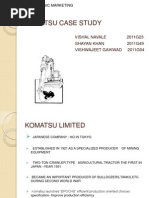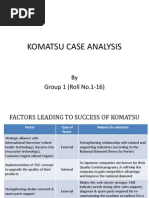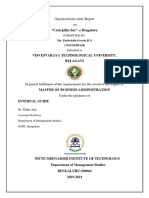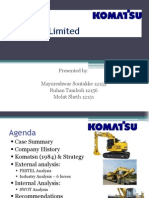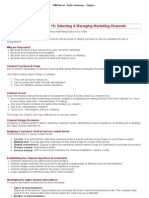Case Study Distribution Channels Komatsu
Case Study Distribution Channels Komatsu
Uploaded by
Rahul Rajasekhar MenonCopyright:
Available Formats
Case Study Distribution Channels Komatsu
Case Study Distribution Channels Komatsu
Uploaded by
Rahul Rajasekhar MenonOriginal Description:
Copyright
Available Formats
Share this document
Did you find this document useful?
Is this content inappropriate?
Copyright:
Available Formats
Case Study Distribution Channels Komatsu
Case Study Distribution Channels Komatsu
Uploaded by
Rahul Rajasekhar MenonCopyright:
Available Formats
Abstract Selection and management of distribution channels are not only part of management functions and daily operation
of multinational corporations (MNCs), but also important compositions of core capability and competitive advantages. This paper first analyzes Komatsu, a well-known Japanese company's strategy of distribution channel of excavators in China from the perspective of distribution channel intensity, then it discusses market function positioning of Komatsu's distributors and Komatsu's control of its distribution channels. Thirdly the paper summarizes characteristics of Komatsu's distribution channels and conduct theoretical thinking on the strategy of distribution channels of MNCs. Finally it suggests that Chinese enterprises learn from the successful experience of Komatsu. Keywords: MNCs, Komatsu, Excavators, Distribution Channel 1. Introduction Nowadays, the competition of MNCs in the global market focuses on two areas: one is the field of product research and development; the other is the field of product distribution. The former is to grab dominated technology position, while the latter is to grab dominated market position. Technologically superior products may not necessarily have a superiority in the market. How to transform the superority in the field of technology to the superiority in the market is a great concern of MNCs. Distribution channel, also known as marketing channel, is the flow channel of products from the producer to the consumer. It consists of the producer, the consumer, and various intermediaries between them. The function of distribution channel is to eliminate asymmetry of information between the producers and consumers so that transactions can be realized. The study of distribution channel concentrates on selection and management of distribution channels, which is the basic research area of marketing theory. In recent years, studies have shown that selection and management of distribution channels have been not only the management functions and daily operations of MNCs, but also an important part in acquiring core competencies and competitiveness advantage for MNCs. Since the reform and opening up, more and more MNCs have entered the Chinese market through a variety of forms. By virtue of their sophisticated marketing experience and creative marketing idea, they have created miracles in many markets. Japan Komatsu Co., Ltd. (hereinafter called Komatsu) is one of them. Komatsu started its production of excavators in China in 1995 in the form of joint ventures in China. The sales of its excavators in China in 2006 reached more than 6,000 units, taking a market share of 16.7%. There are many reasons for Komatsu's success in the Chinese market, but a successful distribution channel strategy, is undoubtedly one of the key factors that help to expand their scale of production. By analyzing the distribution channel of Komatsu's excavators in China, this paper explores the strategy of MNCs in obtaining competitive advantages and provides a reference for cross-border operations for Chinese enterprises. 2. Strategy of distribution channel of Komatsu excavator products in China Komatsu's success in the Chinese market is inseparable from the success of establishing its distribution system in China. Since 2001, Komatsu, with its rich experience of international marketing channel construction, have nurtured and reconstructed China's domestic channel system. 2.1 Intensity of distribution channel At present, the Komatsu excavator network of distribution channels in China covers the country's 31 provinces, municipalities and autonomous regions. There are 34 distributors and 238 affiliated subsidiaries, branches and offices. The channel division strictly follows the basic principle of regional
governance, with an average of 0.94 distributors for each province or municipality and an average of 7.21 branches for each distributor. There may be two distributors being designated in the same province such as Shangdong, Hunan and Sichuan due to intensive users or scarce distribution outlets in these places, while two provinces or autonomous regions such as Gansu, Ningxia may share one distributor because of their user scarceness. Such a distribution density can both ensure that the users of evacuators in each province obtain products and services within a relatively short period and that each distributor has sufficient source of income to maintain market operation and promotional costs, and obtain excess profits and excess rewards given by Komatsu for exceeding annual sales target. In addition, it avoids vicious price competition or market disorder. 2.2 Positioning of distributors with respect to market functions (1) Distributor responsibility system is based on division of market region. Selling and providing services beyond agreed areas are absolutely prohibited. (2) Distributors in different regions are legal units independent from each other. They are autonomous, self-financing and taking the financial risk for failing to operate according to Komatsu operational procedures. (3) Distributors should maintain inventory quantity, variety and quality of evacuators and spare parts authorized by Komatsu. (4) Distributors must accept Komatsu's sales and technical training; establish qualified management standards under the supervision of market representatives and service representatives sent by Komatsu, apply for support from Komatsu for visits to key customer and accept suggestions with regard to inventory vehicles and parts, deal with process-type supervision and management such as report regularly about sales information and financial reconciliation. (5) Qualified distributor should strictly perform their market functions authorized by Komatsu such as promotion, sales, service and support. (6) Distributors must promise not to operate products of Komatsu's rivals, with the exception of noncompetitive products. (7) Regional or national distributors accept the arbitration of Komatsu's Market Supervision Corporation in the event of internal conflict between them. (8) Distributors who succeed in performing their market functions shall be provided additional bonuses and promotion by Komatsu; unqualified distributors shall be punished by disgrading credit, deducting bonuses,even being deprived of qualification. (9) Maintenain the power of implementation of sales process, operating capacity of salesman and service personnel's technical grade, accept regular training and evaluation required by Komatsu. (10) Conduct transactions directly with end consumers in accordance with the market price system and the discount rate, provide products and services according to Komatsu standards and do not cut prices in excess of authority. (11) Make great efforts to recover the purchase price. High-risk tranactions such as payment by installment are not allowed without Komatsu permission.
The channel system does not include dealers. Products are to be sold to the dealers at the average prices to the customers, or distributors are not allowed to offer discounts which are above the standard prices. IIn a rapid growing market like China, it is a wise approach to compress the channel length to the minimum to ensure maximum profits. In addition, no direct sales system is established under this channel system, reflecting Komatsu's sufficient trust in its distributors. 3. Control of distribution channels In the more and more competitve Chinese market, differences of products and sevices between competitors has been increasingly small and marketing tends to be homogenous. Therefore, being in firm control of distribution channels is the sole pathway to obtain adequate profits. Komatsu exercises its control of distribution channels, mainly from the aspects of reward, constraint, price and legal rights. 3.1 Reward For the purpose of raising the market share, Komatsu sets the target of sales units for each distributor and give rewards to the distributors from the collected payment of goods. 3.2 Constraint (1) As noted above, rewards to those distributors who fail to fulfil their sales target and defer payment to Komatsu without any excuses will be deducted at a certain rate. If distributors do not realize the sales and market share targets for a relatively long period, their selling rights will be cancelled. (2) The implementation of distributors star rating system. Under this system, if the distributors meet the specific reqruiements of stnadard in terms of warehouse building, special tools and vehicles in place, staff enrichment, training in place, the number and types of spare parts etc., the distributors will be promoted in terms of reward quotas and training levels. (3) Adopt a common approach in developed countries, require all distributors use an Internet-based distributor database management system and IT technology to enable the work of distributors networking, time-oriented, process-oriented with respect to purchase, inventory, reporting, reimbursement, sales, bad debts, reward, spare parts, service, claims, etc. the purpose of which is to strengthen the management of distribution channels and improve efficiency. 3.3 Price Komatsu sets a unified market retail price for distributors and strict rules of discounts enjoyed by distributors at different levels. It not only determines the price and discount level, but also make stringent regulations on standards for fee collection with regard to freight, renovation services, supply levels of spare parts, repairs and minor repairs and claim standards, etc. 3.4 Leagal rights Komatsu has review and approval rights with regard to the use of core technology and intellectual property right, information reported, summary, disclosure, communication, etc. In additon, it established stringent requirements for the use of intangible assets. Komatsu expressly authorizes distributors at all levels. Act of the distributors beyond their authority is strictly prohibited. 4. Analysis on the strategy of distribution channels of Komatsu in China
4.1 Wide distribution channel Komatsu has a number of intensive distributors for selling excavators in China which in turn provides wide channel coverage and makes its goal of penetration into a broader regional segment markets and acquiring a higher market share possible. Of course, such a wide-channel also means increased workload for Komatsu in coordinating channel operation and resolving channel conflict issues. 4.2 Reasonable geographical division of the channel Reasonable geographical division of the channel avoids unnecessary conflicts between channel members. Sufficient market area provides distributors with sufficient client resources, the principle of " more pay for more work" encourages distributors in opening up markets as well as efforts in increasing market share. 4.3 Localization advantage of the selected distributors Local distributors are familiar with the local market conditions, cultural customs and consumer psychology. Thus, they have unique advantages with respect to project operation and customer's relationship. Meanwhile, specializing in Komatsu excavators increases distributors concentration and is conducive to promote their professional quality. 4.4 The approach of fostering and nurturing distributors Distributors are required to implement the strict management measures and Komatsu often sends staff to carry out real-time monitoring. The marketing capability and management level of the distributors are thus promoted, which is conducive to sustained and long-term distribution operation and to the maintainance of stable distribution channel. 4.5 Attach importance to the communication with distributors Komatsu has a high degree of management localization in China. Many senior managers are mainlandborn Chinese who are concerned with the domestic market. They give enthusiastic support to the development of distributors and pay regular visits to distributors. They adopt the method of repeated consultations when encountering serious problems rather than taking a simple confrontation approach in dealing with confrontation. 5. Theoretical thinking on the distribution channel strategy of Komatsu excavators in China 5.1 The design concept of the value chain of Komatsu distribution channels According to Michael Porter's elaboration of the synergistic effect of value chain, activities within the enterprise can be decomposed of a number of components from the perspective of the strategic importance and their combination will create value. Extended studies of the theory have shown that the value chain of a single enterprise can be decomposed and integrated to form an external collaboration system consisting of a number of independent members with different functions. From the analysis of the whole value chain, large-sized manufacturing enterprises may give up some value added segments and design their own value chain system in order to seek partners who will be cultivated to increase their core competitiveness and jointly complete the whole process of value chain. The value chain of distribution channel of construction machinery is composed of manufacturers, distributors or dealers/ retailers and end consumers. This paper argues that, manufacturers and end
consumers who are in the two ends of the value chain both have the initiative for interests. Through the market segmentation and target market positioning, manufacturers may determine the end-user groups, end-user groups can also choose different suppliers according to their own interests at different time. In promoting co-operation between the two, and formally starting realization of transformation of value with each other, distribution channels between them play a vital role. 5.2 The synergy effect of distribution channel members and enhancement of performance In implementing distribution channel strategy, it is a critical path to study channel relationships and explore how to build and deal with channel relationships. When Komatsu first entered Chinese market, Komatsu faced the problem of the lack of distribution channels in China's domestic market. By the virtue of its global experience in distribution channel construction, Komatsu adopted the strategy of strict management together with careful nurture of distribution channels, creating distribution channels of its own characteristics suitable for excavators in China. Strict management enables domestic distributors make substantial progress in professional quality. Careful nurture helps Komatsu build appropriate channel system aimed at acquiring marketshare. The domestic channels, after experiencing a severe test, also acquire mature marketing management experience and operational skills. Such inter-organizational collaboration and cooperation undoubtedly have raised the stability of the system and increased mutual trust. The construction in IT, channel performance appraisal and hardware construction has also benefited distributors. The overall efficiency of the channels has been improved substantially. 6. Concluding remarks Along with the thorough promotion of China's "marching out" strategy in the recent decade, more and more Chinese enterprises have been entering international market, but compared with the MNCs of developed countries, Chinese enterprises lack experience in cross-border investment. It is therefore significant for them to learn from the successful experience of MNCs of developed countries. It is hoped that the strategy of Komatsu excavator distribution channels in China can provide some useful lessons for Chinese enterprises.
You might also like
- F.20 Polaris & Victory QuestionsDocument3 pagesF.20 Polaris & Victory QuestionsGopiGuniganti0% (1)
- Quiz - Environmental Scanning and Industry AnalysisDocument2 pagesQuiz - Environmental Scanning and Industry AnalysisJham Ellen Daylusan43% (7)
- Komatsu Case StudyDocument9 pagesKomatsu Case StudyVishal NavaleNo ratings yet
- Production and Service Planning II Case Study Macpherson Refrigeration Limited PDFDocument15 pagesProduction and Service Planning II Case Study Macpherson Refrigeration Limited PDFArth GuptaNo ratings yet
- MiroglioDocument1 pageMiroglioDevrat SinghNo ratings yet
- Mining The Abode of Gods Vedanta and Mining Investments in OrissaDocument11 pagesMining The Abode of Gods Vedanta and Mining Investments in OrissaRONIT BANERJEANo ratings yet
- KOMATSU Case SolutionDocument6 pagesKOMATSU Case SolutionVinnakota Harish50% (6)
- Principles A N D Practice of Marketing: David JobberDocument3 pagesPrinciples A N D Practice of Marketing: David JobberItachi90No ratings yet
- Acquisition of Essar Steel by ArcelorMittalDocument3 pagesAcquisition of Essar Steel by ArcelorMittalAmisha JainNo ratings yet
- Caterpillar CompititorDocument2 pagesCaterpillar CompititorA.Rahman SalahNo ratings yet
- Case 3 KomatsuDocument3 pagesCase 3 Komatsugiadcunha0% (1)
- Secretary of Defense: Fellows ProgramDocument48 pagesSecretary of Defense: Fellows ProgramMuhammad Ali PervaizNo ratings yet
- Cat Vs Komatsu 4 DekadeDocument7 pagesCat Vs Komatsu 4 DekadeAji AjaNo ratings yet
- KOMATSU Case SolutionDocument6 pagesKOMATSU Case SolutionSujeeth BharadwajNo ratings yet
- Case Millennium TSS J v1Document6 pagesCase Millennium TSS J v1killer drama100% (1)
- Marketing KomatsuDocument4 pagesMarketing KomatsuRakesh KallaNo ratings yet
- Instructor Manual Flying Too Low Air India 2009 & BeyondDocument7 pagesInstructor Manual Flying Too Low Air India 2009 & BeyondArunkumarNo ratings yet
- Analysis of Vodafone CaseDocument13 pagesAnalysis of Vodafone CaseRinni JainNo ratings yet
- Industry Classification Benchmark - Wikipedia, The Free EncyclopediaDocument5 pagesIndustry Classification Benchmark - Wikipedia, The Free Encyclopediasergio_tslNo ratings yet
- g0 Core Caterpillar Case StudyDocument4 pagesg0 Core Caterpillar Case StudyMohtada MorsyNo ratings yet
- Remanfacturing The Ultimate Form of Recycling 1Document27 pagesRemanfacturing The Ultimate Form of Recycling 1Roshan Khedkar100% (1)
- B2B Presentation CaterpillarDocument12 pagesB2B Presentation Caterpillarmesay83No ratings yet
- SHRM Case Analysis 2Document4 pagesSHRM Case Analysis 2SAntosh TamhaneNo ratings yet
- Tata CommunicationsDocument19 pagesTata CommunicationsSumit Kapoor100% (1)
- 24M RDSLDocument9 pages24M RDSLjogremaurNo ratings yet
- Caterpillar Case StudyDocument6 pagesCaterpillar Case StudykhanNo ratings yet
- Komatsu caseQuestionsCaseB497Fall2009Document9 pagesKomatsu caseQuestionsCaseB497Fall2009clairerj29No ratings yet
- Five ForceDocument28 pagesFive ForceSulogna Kumar PanNo ratings yet
- Cat CaseDocument3 pagesCat CaseFahad Chowdhury100% (1)
- IFM Midterm QuestionsDocument7 pagesIFM Midterm QuestionskatnavNo ratings yet
- Tata Comm SMDocument38 pagesTata Comm SMDeepit SachdevNo ratings yet
- Caterpillar SWOT Analysis 2022Document12 pagesCaterpillar SWOT Analysis 2022A.Rahman Salah100% (1)
- Strategic Product Development of E-VehicleDocument32 pagesStrategic Product Development of E-VehiclesanchitNo ratings yet
- Team4 BYD CASEDocument8 pagesTeam4 BYD CASEinsta instaNo ratings yet
- Indian Aviation Sector Political Factors: PESTEL AnalysisDocument3 pagesIndian Aviation Sector Political Factors: PESTEL AnalysisAatish PanditNo ratings yet
- Inside Tata Digital's Plan To Integrate Online Businesses and Launch A Super AppDocument8 pagesInside Tata Digital's Plan To Integrate Online Businesses and Launch A Super Appvikasaggarwal01No ratings yet
- Ongc Growth StrategyDocument10 pagesOngc Growth StrategydhavalmevadaNo ratings yet
- Digital Disruption at The Grocery StoreDocument8 pagesDigital Disruption at The Grocery StoreDanica Diamante100% (1)
- Sales Guide - October 2020Document9 pagesSales Guide - October 2020ThepowerNo ratings yet
- Indian Manufacturing Sector Bottlenecks For Value ChainDocument27 pagesIndian Manufacturing Sector Bottlenecks For Value ChainBrijesh RamaniNo ratings yet
- OS Report On Caterpillar - IncDocument40 pagesOS Report On Caterpillar - IncAkshay BondNo ratings yet
- Vitality-Case Analysis: Vitality Health Enterprises IncDocument5 pagesVitality-Case Analysis: Vitality Health Enterprises IncChristina Williams0% (1)
- Relationship Marketing ToyotaDocument9 pagesRelationship Marketing ToyotaNadiah Muhamad Basri100% (1)
- Komatsu V3 - 13.9Document27 pagesKomatsu V3 - 13.9Adneya Audhi100% (2)
- ISolutions Lifecycle Cost ToolDocument8 pagesISolutions Lifecycle Cost ToolpchakkrapaniNo ratings yet
- Tyre Industry in IndiaDocument11 pagesTyre Industry in IndiaAlok ChowdhuryNo ratings yet
- ED Auto PresentationDocument25 pagesED Auto PresentationRaghav NevatiaNo ratings yet
- Group 1 - ABGDocument12 pagesGroup 1 - ABGshubhamNo ratings yet
- Case Synopsis Nestle and Alcon The Value of ListingDocument4 pagesCase Synopsis Nestle and Alcon The Value of Listingavnish kumarNo ratings yet
- Tta Motors Interview GDDocument2 pagesTta Motors Interview GDLucky SrivastavaNo ratings yet
- DMRC Case Analysis PDFDocument6 pagesDMRC Case Analysis PDFAbhiramyNo ratings yet
- MADA5 ADocument28 pagesMADA5 AHimanshu JaiswalNo ratings yet
- Liebherr T 282 C Job Report Peabody North Antelope Rochelle MineDocument2 pagesLiebherr T 282 C Job Report Peabody North Antelope Rochelle MineNicolás Alberto RojasNo ratings yet
- JCBDocument8 pagesJCBOjantaNo ratings yet
- Global Electric Car IndustryDocument26 pagesGlobal Electric Car IndustryHanisevae VisantiNo ratings yet
- Cashman EM Solutions Brochure 3 16Document2 pagesCashman EM Solutions Brochure 3 16jov100% (1)
- Organization Study: Mangalore Chemicals and Fertilizers LTDDocument14 pagesOrganization Study: Mangalore Chemicals and Fertilizers LTDHariprasad bhat0% (1)
- Project - 3M India Filtrete LaunchDocument6 pagesProject - 3M India Filtrete Launchmandeep sh100% (1)
- RPG Enterprises Group Strategy: Team Name: Case-A-Novas Members: Keerthan G Abhishek Pai Pradeep KDocument11 pagesRPG Enterprises Group Strategy: Team Name: Case-A-Novas Members: Keerthan G Abhishek Pai Pradeep KSuman MandalNo ratings yet
- Group - 8 OtislineDocument2 pagesGroup - 8 OtislinevNo ratings yet
- Kotler Summary - Chapter 15 Selecting & Managing Marketing ChannelsDocument4 pagesKotler Summary - Chapter 15 Selecting & Managing Marketing Channelsmunna1245No ratings yet
- Blue Nile Case NotesDocument18 pagesBlue Nile Case Notesenergizerabby100% (1)
- Marketing Content Media Communication Strategist in Los Angeles CA Resume Sarah NettingaDocument2 pagesMarketing Content Media Communication Strategist in Los Angeles CA Resume Sarah NettingaSarahNettingaNo ratings yet
- Nature Industrial Marketing (Kazim, Manu,)Document12 pagesNature Industrial Marketing (Kazim, Manu,)Anshul ShahNo ratings yet
- True Nopal Cactus Water Announces Verification With The Non-GMO ProjectDocument4 pagesTrue Nopal Cactus Water Announces Verification With The Non-GMO ProjectPR.comNo ratings yet
- Industrial Marketing 2Document3 pagesIndustrial Marketing 2Ahmad NoorNo ratings yet
- ECO101 Problem Set 12 OligopolyDocument2 pagesECO101 Problem Set 12 OligopolyALINo ratings yet
- Research PaperDocument10 pagesResearch PaperAleeza AnjumNo ratings yet
- 6401.0 Consumer Price Index, Australia TABLES 1 and 2. CPI: All Groups, Index Numbers and Percentage ChangesDocument34 pages6401.0 Consumer Price Index, Australia TABLES 1 and 2. CPI: All Groups, Index Numbers and Percentage ChangesTech TucksNo ratings yet
- Reading - Developing A Brand Identity That LastsDocument4 pagesReading - Developing A Brand Identity That LastsFTU.CS2 Đinh Bảo TrâmNo ratings yet
- Buy Indian Instagram Followers OnlineDocument6 pagesBuy Indian Instagram Followers Onlinenetsviral6No ratings yet
- Summary Module 2Document30 pagesSummary Module 2Saad RashidNo ratings yet
- Imc Plan Part1Document21 pagesImc Plan Part1api-658984705No ratings yet
- 07 - M. Khairul Hanif - 2106111215 - Tugas Materi 5Document4 pages07 - M. Khairul Hanif - 2106111215 - Tugas Materi 5M. Khairul Hanif 2106111215No ratings yet
- Marketing, Design and Communications: Student Name: Unite Code: Name of Company: Bottega VenetaDocument13 pagesMarketing, Design and Communications: Student Name: Unite Code: Name of Company: Bottega VenetaS RahmanNo ratings yet
- Agricultural ExtensionDocument25 pagesAgricultural ExtensionJohnmark Dinglasa-Ladeza GullesNo ratings yet
- Selling Proposition and Value PropositionDocument27 pagesSelling Proposition and Value PropositionRhea May Peduca0% (1)
- Aava ProjectDocument32 pagesAava Projectyogesh0794No ratings yet
- New Microsoft Word DocumentDocument2 pagesNew Microsoft Word DocumentPriyanka SrivastavaNo ratings yet
- Business Advantage Advanced Unit2 Standardisation and DifferentiationDocument5 pagesBusiness Advantage Advanced Unit2 Standardisation and DifferentiationIgnacio Lombardi0% (1)
- Our Businesses: Retail Brands (16) Hospitality Brands (7) Mall ManagementDocument10 pagesOur Businesses: Retail Brands (16) Hospitality Brands (7) Mall Managementgayathrir_23047138No ratings yet
- Study of Consumer Buying TelevisionDocument10 pagesStudy of Consumer Buying TelevisionVinayNo ratings yet
- E Business ModelsDocument46 pagesE Business Modelskatoch_manu22895100% (3)
- Converting Web Site Visitors Into Buyers How Web SDocument18 pagesConverting Web Site Visitors Into Buyers How Web SMy Huynh Kim ThaoNo ratings yet
- Angela Serednicki - Digital Coordinator Mississauga PDFDocument2 pagesAngela Serednicki - Digital Coordinator Mississauga PDFAngela SerednickiNo ratings yet
- Summer Internship Report Sumit KumarDocument70 pagesSummer Internship Report Sumit Kumarsaurav kumarNo ratings yet
- Certified Manager of Quality/ Organizational ExcellenceDocument61 pagesCertified Manager of Quality/ Organizational ExcellenceRafat AlghubariNo ratings yet
- Boston Consulting Group (BCG)Document30 pagesBoston Consulting Group (BCG)LEZIEL ASINONo ratings yet
- Aron Smith CV Assistant PDFDocument2 pagesAron Smith CV Assistant PDFJuja FlorentinoNo ratings yet


